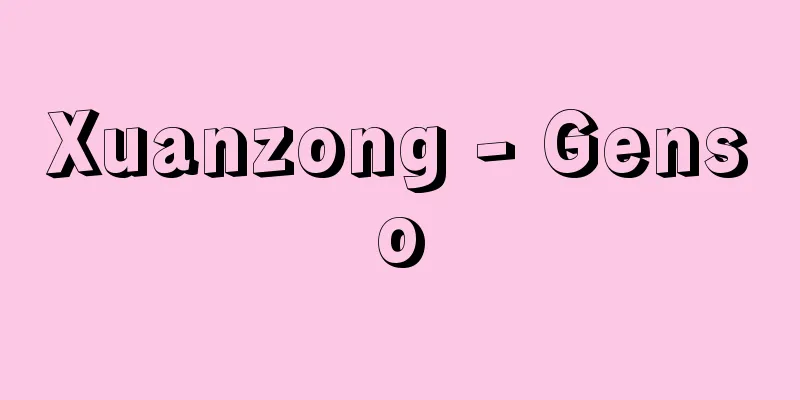Yin

|
The name of an ancient Chinese dynasty. However, they called themselves "Shang," and the Zhou dynasty that destroyed them called the previous dynasty "Yin." In modern China, it is often called "Shang." There are various theories about its date, but it is thought to have been from roughly the border between the 17th and 16th centuries BC to around the middle of the 11th century BC. [Matsumaru Michio] Legends and the discovery of oracle bonesAccording to the Records of the Grand Historian, the Yin Dynasty and other ancient documents, the mother of the founder Qi, Jian Di, was the daughter of the You clan and the second wife of Emperor Huo. She swallowed a swallow's egg to give birth to Qi, who helped Emperor Yu control the floods and was given the title of Shang by Shun and given the surname Zi. From the next emperor, Zhaoming, to the 12th emperor, Shuqi (Shuqi in oracle bone script), the succession was by father and son, and was then succeeded by Tianyi (Chengtang, Dayi in oracle bone script). Prior to this, the capital had been moved eight times, but during the reign of Chengtang, it was moved to Bo (possibly near Cao County, Henan Province), after which he defeated King Jie of Xia, took the title of King Wu, and became emperor. This marked the beginning of the Shang dynasty. The capital was moved frequently thereafter, and it is said to have been moved five times by the time of the 18th emperor, Pan Geng. During the reign of the 30th emperor, Xin (Chu), the country fell into great turmoil and was destroyed by the Zhou dynasty, which rose to power in the west. For a long time, it was unclear whether these legends in historical records were in fact historical facts, but in 1899, the Huao River, which flows beside a village called Xiaotun near Anyang County in Henan Province, flooded and collapsed its banks, revealing numerous fragments of tortoise shells and animal bones with inscriptions. Liu Tieyun, who came into possession of these by chance, deciphered the characters and was able to read many of the names of the kings of the Shang dynasty from the aforementioned documents. This confirmed that these were relics from the Shang dynasty, and conversely, that the descriptions in the historical records were not fictional, but that the Shang dynasty actually existed. Subsequently, many oracle bone fragments were discovered in the same region, and between 1928 and 1937, a large-scale excavation was carried out by the Academia Sinica Institute of History and Philology, which uncovered a huge number of oracle bone fragments as well as the remains of a huge royal tomb, a palace, and countless other relics and ruins. This led to the belief that this was the so-called Yin Ruins mentioned in the Records of the Grand Historian, and that this site was likely the site of the capital from Pangen to the last emperor, Xin. This is said to be the greatest discovery in Chinese archaeology and ancient history research of the 20th century. Historical records state that there was a Xia dynasty that preceded this, but as no relics or ruins to prove its existence have yet been found, the Yin dynasty is currently the oldest dynasty confirmed in Chinese history. [Matsumaru Michio] Politics, Society, and CultureDue to the circumstances mentioned above, the materials for elucidating the society and culture of the Shang dynasty are almost limited to the results of deciphering oracle bones and archaeological findings. The oracle bones are inscribed with the results of divination performed by the Shang royal court's diviners to inquire of the will of the Heavenly Emperor, who the Shang people considered to have control over the human world, on all aspects of the Shang dynasty's rituals, agriculture, weather, invasions and subjugation of foreign enemies, the king's travels, hunting, illnesses, and so on. There are particularly many divinations related to rituals, which can be divided into cases where the divination is aimed at the ancestral gods of the Shang royal court's former kings and mothers, and cases where the divination is aimed at natural gods such as rivers and mountains. In the sense that worshiping these gods was central to the formation of political order, it can be said that the political form was one in which religion and politics were one and the same. The royal capital is called "Daiyau" in the oracle bones, but there were many clan villages surrounding it, which served as the residences of the ruling aristocracy, and it is believed that many smaller villages were subordinate to these clan villages. The hierarchical relationships of dominance and subordination between these villages formed the basis of the state structure, which is called a village-based state or city-state. In the royal capital, a certain degree of the formation of a ruling bureaucratic class can already be seen. Economically, agriculture is thought to have been the mainstay of the country, with millet, foxtail millet, barley, and other crops cultivated, livestock (cattle, horses, sheep, pigs, dogs, chickens, etc.) kept, and sericulture also carried out. There is no consensus as to whether or not production slaves were used for these purposes, but the oracle bone inscriptions mention a large number of foreign tribes known as the Qiang, who were used as sacrifices in rituals, and the fact that a great number of human bones have been excavated around the royal tombs during excavations suggests that foreign slaves were widespread. Culturally, the most distinctive feature of this period is that it coincided with the height of China's Bronze Age culture. Archaeologically, the entire Shang dynasty is usually divided into the early Erlitou period, the middle Zhengzhou period, and the late Anyang period. The beginnings of bronzeware in Chinese history can be seen in the Erlitou period, but by the middle period, large, elaborate bronze ritual vessels were already being produced in large numbers, and by the late period, bronze ritual vessels and weapons of astonishing quality and quantity were being produced. As bronzeware cast using the outer division method, it shows the highest level of technical perfection. Furthermore, with its complex patterns, it is considered to be the pinnacle of ancient Bronze Age culture on a global scale. There are many aspects of the origin of the Yin civilization that remain unclear. It is recognized that the Mesopotamian, Egyptian, and Indus civilizations, as well as the Mesoamerican and Andean civilizations, are all mutually related among the so-called six great civilizations of the world. However, the relationship between the Yin civilization and these civilizations remains to be elucidated in the future. [Matsumaru Michio] "The Ancient Yin Empire" edited by Shigeki Kaizuka (1957, Misuzu Shobo)" ▽ "The Mystery of the Ancient Yin Dynasty by Michiharu Ito (1967, Kadokawa Shoten)" ▽ "The Structure of the Yin-Zhou State by Michio Matsumaru" (included in "Iwanami Lecture Series World History 4: Ancient Times 4", 1970, Iwanami Shoten) [Reference] |©Shogakukan "> Yin Dynasty / A brief genealogy of the dynasty ©Shogakukan "> Distribution of Yin Dynasty ruins Source: Shogakukan Encyclopedia Nipponica About Encyclopedia Nipponica Information | Legend |
|
中国古代の王朝の名称。ただし、自名としては「商」と称し、これを滅ぼした周が前代の王朝を「殷」と称した。現在の中国では「商」とよぶ場合が多い。年代については諸説あるが、ほぼ紀元前17、16世紀の境より、前11世紀なかばごろまでと考えられる。 [松丸道雄] 伝承と甲骨文の発見『史記』殷本紀その他の古文献によれば、始祖契(せつ)の母簡狄(かんてき)は、有(ゆうじゅう)氏の娘で帝嚳(ていこう)の次妃であったが、玄鳥(ツバメ)の卵を呑(の)んで契を生み、契は禹(う)の治水を助け、舜(しゅん)によって商に封ぜられて、子姓を賜った、とされる。次代の昭明より第12代主癸(しゅき)(甲骨文では示癸)まで父子相続が行われ、その後、天乙(てんいつ)(成湯(せいとう)、甲骨文では大乙)が継いだ。これ以前、都を8回移したが、成湯のとき、亳(はく)(河南(かなん/ホーナン)省曹県近くか)に移ったのち、夏(か)の桀王(けつおう)を滅ぼし、武王と号し、天子の位についた。ここに殷王朝が始まる。それ以後もしばしば遷都が行われ、成湯から数えて第18代の盤庚(ばんこう)のときまでに5回移った、とされる。第30代帝辛(ていしん)(紂(ちゅう))のとき、国は大いに乱れ、西方に興った周によって滅ぼされたという。 このような史書中の伝承が、はたして史実であったか否かについては、長らく不明であったが、1899年、河南省安陽(あんよう/アンヤン)県近くの小屯(しょうとん)という村のわきを流れる洹河(えんが)が氾濫(はんらん)して堤防が崩れ、そこから、文字を刻した亀甲(きっこう)や獣骨の断片が多数発見された。偶然のきっかけから、これらを入手した劉鉄雲(りゅうてつうん)が、この文字を解読した結果、これらのうちに、前記の文献中の殷の王名が多数、読みとられた。これによって、これらが殷代の遺物であること、また逆に、史書中の記述が架空のものではなく、殷王朝が実在したことが確実になった。その後、甲骨片は同地域で多数発見され、1928~37年の間に中央研究院歴史語言研究所の手によって大規模な発掘が行われ、大量の甲骨片とともに、巨大な王墓や宮殿跡、その他無数の遺物、遺跡が発見されて、ここが『史記』にいういわゆる殷墟(いんきょ)であり、この地が、盤庚から末王帝辛までの都址(とし)であろうと考えられるに至った。20世紀、中国考古学、古代史研究における最大の発見といわれる。史書では、これに先行する夏王朝が存在したとされるが、その実在を証明する遺物、遺跡が未発見であるため、現在、殷王朝が中国史上、確認される最古の王朝である。 [松丸道雄] 政治・社会・文化前述の経緯から、殷代社会、文化の解明のための資料は、甲骨文の解読結果と考古学的知見とにほぼ限られる。甲骨文は、殷王室の卜官(ぼくかん)によって、殷王朝の祭祀(さいし)、農耕、天候、外敵の侵攻と征伐、王の行旅、狩猟、疾病等々、万般にわたって、殷人が人間世界に支配力を有すると考えた天帝に、その神意を問いただすために行われた占いの結果を書き刻んだものである。とりわけ祭祀に関する占卜(せんぼく)が多く、これは、殷王室の先王先妣(せんぴ)のいわば祖先神を対象とした場合と、河、岳など自然神を対象とした場合に分けられる。これらを祀(まつ)ることが政治における秩序形成の中核をなしていたという意味で、祭政一致の政治形態をもったといえよう。王都は、甲骨文中で「大邑(たいゆう)」とよばれているが、これを取り巻く氏族邑が多数存在して支配貴族の住地となり、さらにこれら氏族邑には多数の小邑が隷属していたと考えられる。これらの邑相互の累層的支配隷属関係が国家構造の基本であって、これを邑制国家ないし都市国家とよぶ。王都には、すでにある程度の支配官僚層の形成が認められる。 経済的には農業が中心であったと考えられ、キビ、アワ、大麦などが栽培されたほか、家畜(ウシ、ウマ、ヒツジ、ブタ、イヌ、ニワトリなど)を飼い、また養蚕も行われた。これらのために生産奴隷が使用されたかどうかには、まだ定説がないが、甲骨文中に羌(きょう)とよばれる異族が多数、祭祀の犠牲として用いられており、また発掘される王墓周辺から実際におびただしい殉葬人骨が出土するところからすれば、異族奴隷の広範な存在は否定できない。 文化的にもっとも特徴的なのは、この時期が中国青銅器文化の最盛期にあたっている点である。考古学的には、殷代全期を、前期・二里頭(にりとう)期、中期・鄭州(ていしゅう)期、後期・安陽期に区分するのが通例である。中国史上の青銅器の萌芽(ほうが)は二里頭期に認められるが、中期には早くも大型の精巧な青銅祭器類が多数制作されるようになり、後期に至ると質量ともに驚嘆すべき青銅祭器、武器などがつくられた。外范(がいはん)分割法によって鋳造された青銅器として、技術的に最高の完成度をみせている。かつ、複雑な文様を付して、世界的にみて古代青銅器文化の粋とされる。 こういった殷文明の来源については未解明の部分が多い。いわゆる世界六大文明のうち、メソポタミア・エジプト・インダス諸文明、およびメソアメリカ・アンデス両文明が、それぞれ相互に関係していることは認められている。しかし殷文明のみは、これらとの間にどのような関係があったかについては、今後の解明にゆだねなければならない。 [松丸道雄] 『貝塚茂樹編『古代殷帝国』(1957・みすず書房)』▽『伊藤道治著『古代殷王朝のなぞ』(1967・角川書店)』▽『松丸道雄著「殷周国家の構造」(『岩波講座 世界歴史4 古代4』所収・1970・岩波書店)』 [参照項目] |©Shogakukan"> 殷/王朝略系図 ©Shogakukan"> 殷代の遺跡分布 出典 小学館 日本大百科全書(ニッポニカ)日本大百科全書(ニッポニカ)について 情報 | 凡例 |
Recommend
Sound Piece - Onseppen
...This segmentation is called "secondary se...
Jean-Marie-Mathias-Philippe-Auguste Villiers de l'Isle-Adam
1838‐89 French poet and novelist. Born into a nobl...
Khalij 'Umān (English spelling) Khalij Uman
The Strait of Hormuz is a strait that connects th...
Gonoura [town] - Gonoura
An old town in the southwest of Iki Island, Iki Di...
Anelio, GF - Anelio
A cappella is a group of musicians who composed c...
Kodok millet (English spelling) Kodok millet
…Dallisgrass and bahiagrass are used as pasture g...
Jia Bao-yu (English name)
The protagonist of Cao Xueqin's novel "Dr...
Tree limit - Koubokugenkai
This refers to the limit, or boundary line, of th...
Nasu clan
A medieval samurai family based in Nasu County, Sh...
Thrips (Thysanoptera) - thrips (English spelling)
A general term for insects belonging to the order ...
Depero, F. (English spelling) DeperoF
...Boccioni in particular was the painter most fa...
Canoe - canoe (English spelling)
A small boat with a primitive structure that does...
Fukuratsu
A port located in Shika Town, Ishikawa Prefecture,...
Stone hoe - Ishiguwa
…Farming tools [Ochi Toshiaki] [Primitive/Ancient...
Henri, L. - Anri
...The most representative example of this is the...








![Tomoemon Otani [7th generation]](/upload/images/67cfc37b288f2.webp)
